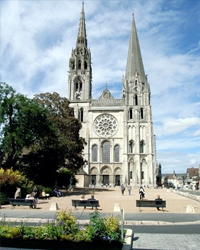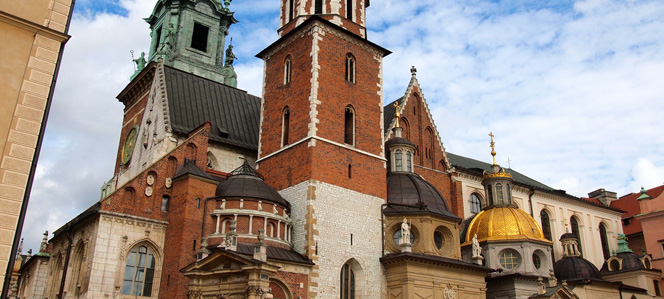A Secular Europe and the Mission of the Church
By Fr. Robert Barron
 I’ve just returned from a wonderful trip to Europe, where my team and I were filming for our ten-part documentary on Catholicism. We journeyed throughout France, Germany, and Poland, taking in some of the artistic and architectural glories of European Catholicism. We photographed at Notre Dame Cathedral and Sainte Chapelle in Paris, at Chartres Cathedral, at the Unterlinden Museum in Colmar which houses Grunewald’s magnificent Isenheim altarpiece, at the imposing Cathedral of Cologne in Germany, and finally at Wawel Cathedral in Kracow. Our purpose was to use these works of art as an aesthetic accompaniment to my spoken elaboration of certain basic themes within the theology and spirituality of the church.
I’ve just returned from a wonderful trip to Europe, where my team and I were filming for our ten-part documentary on Catholicism. We journeyed throughout France, Germany, and Poland, taking in some of the artistic and architectural glories of European Catholicism. We photographed at Notre Dame Cathedral and Sainte Chapelle in Paris, at Chartres Cathedral, at the Unterlinden Museum in Colmar which houses Grunewald’s magnificent Isenheim altarpiece, at the imposing Cathedral of Cologne in Germany, and finally at Wawel Cathedral in Kracow. Our purpose was to use these works of art as an aesthetic accompaniment to my spoken elaboration of certain basic themes within the theology and spirituality of the church.
As we were finishing our filming in Sainte Chapelle, that jewel-box of a Gothic building, designed in the thirteenth century to house the relic of the crown of thorns, I turned to John Cummings, our cameraman, and said, “well, what did you think of this place?” He replied, “it’s amazing, but finally, it’s one more empty church.” John’s comment, telling and insightful, has stayed in my mind. More often than not, the monuments of European Catholicism are like objets d’art in a dusty museum of culture, rather than expressions of a living faith. Mass attendance is notoriously low throughout Europe (Poland is the exception that proves the rule), and the dominant European attitude toward Christianity seems to be bored indifference. Indeed, on a cold Sunday morning, our team attended Mass at Chartres Cathedral and found that the liturgy was poorly attended and the average age of the participants high. At the Unterlinden Museum, we were privileged to have a very bright doctoral candidate as our guide. She spoke five languages fluently and was well versed in contemporary Italian literature and art, but she was so uninformed about Christianity that she felt obliged to ask me the meaning of the phrase, found on the altarpiece, “a virgin will give birth and we shall call him Emmanuel.”
Now the reasons for this attenuation of Christianity in Europe are various, and the issue has been explored from numerous angles, especially in the last few decades. Many scholars have pointed to the modern critique of a church grown far too cozy with political and cultural power. Others have pointed to the skepticism and atheism of Nietzsche, Marx, Comte, Freud, and Feuerbach, which gradually trickled down from the high culture to the popular level and became, in time, a sort of consensus view. Still others argue that the individualism, materialism and consumerism at the heart of the modern worldview militate against a vibrantly imagined Christianity, especially in its Catholic expression. I would like to add still another perspective. The orgy of violence that occurred in the heart of Europe in the twentieth century, including two world wars and two nearly successful attempts at genocide, ruptured something in the European spirit. Many wondered how, after such a cataclysm, belief in a loving God and in the human being fashioned after the divine image could be taken seriously. For these reasons, and many others beside, Europe suffered, to state it pithily, a loss of the sense of the transcendent. And the empty churches noticed by John Cummings are the consequence.
Having acknowledged this state of affairs, what precisely is the way forward? I believe that we should recover a sense of the church as witness. The church’s fundamental role in any culture and at any time is to bear witness to Jesus and his resurrection. When the first Christians proclaimed this message, they were met, for the most part, with opposition. We hear in the Acts of the Apostles that when Paul preached the resurrection on the Areopagus in Athens, most people scoffed and walked away. In the first few centuries of the church’s life, Christians faced, more often than not, hostility, and in extreme cases persecution unto death. After the time of Constantine, the church found a much more hospitable cultural environment, and by the period of the high Middle Ages, its message had come dramatically to shape the whole of society. Chartres, Notre Dame, Sainte Chapelle, the writings of Thomas Aquinas and Duns Scotus, and the Divine Comedy of Dante all come from this confident and vibrant epoque. With the rise of Protestantism and then secular modernity, the church found itself situated much more ambiguously in relation to the wider culture, and as we’ve seen, in our own time, its message of Jesus’ resurrection is met, at least in Europe, with a yawn.
So it goes, and so it has always gone. Cultural forms shift; opposition to the church waxes and wanes; sometimes the Gospel is with the flow and sometimes it runs against the grain. Chartres was the finest flower of the Christian culture; and now it is mostly the haunt of tourists. But through it all, in season and out, either as a dominant force or, in the words of Benedict XIV, a “creative minority,” the Church witnesses to Jesus Christ and his resurrection from the dead. In that, it finds, not necessarily success, but its identity.
